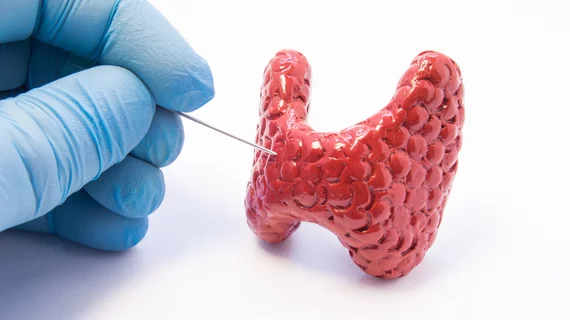ACR's thyroid imaging reporting and data system 'dramatically' reduces unnecessary nodule biopsies
Thyroid nodules are common and frequently biopsied unnecessarily but using the American College of Radiology’s Thyroid Imaging Reporting and Data System (TI-RADS) has been shown to reduce fine needle aspirations significantly.
A new study published recently in Cureus examined the outcomes of thyroid nodule fine needle aspirations to biopsy recommendations based on local best practice guidelines versus ACR TI-RADS. Researchers found that implementing ACR TI-RADS reduced unnecessary biopsies dramatically.
“The rising use of imaging over the last four decades has led to a significant increase in nodule detection or ‘over-identification,’ fine-needle aspiration (FNA), a higher reported incidence of thyroid cancer, and thyroidectomy,” corresponding author Bader Abou Shaar, a medical student with the department of radiology at Alfaisal University College of Medicine, and co-authors wrote. “Despite the increasing radiological, pathological, and surgical interventions associated with thyroid nodules, low thyroid cancer mortality rates worldwide have not significantly changed.”
Although thyroid nodules are identified in up to 76% of adults, less than 10% are palpable and the majority are found incidentally during routine imaging. To address the overdiagnosis of thyroid nodules that are recommended for FNA, several risk stratification systems were implemented, including the American Thyroid Association (ATA) risk stratification system, Korean Society of Thyroid Radiology Thyroid Imaging Reporting and Data System (K-TIRADS), American Association of Clinical Endocrinologists (AACE), European Thyroid Association TIRADS (EU-TIRADS) and the American College of Radiology (ACR) TI-RADS.
This study, Abou Shaar B, Meteb M, Awad El-Karim G, et al., focused their efforts on the ACR TI-RADS, measuring FNA incidence one year prior to and one year after implementing the system. During that time, the experts examined the outcomes of 104 patients with 114 thyroid nodules. Cytology results were available for all patients, who were divided into two groups to measure outcomes—a local best practice cohort (based on the ATA system) and a TI-RADS cohort.
After implementing ACR TI-RADS in January 2018, the experts noted a substantial reduction of 52.6% in unnecessary FNAs. Using local best practice guidelines, those nodules would have previously required costly biopsies.
“This is a considerable amount given the amount of resources, costs, and patient anxiety that could have been averted,” the researchers said.
Though the ACR TI-RADS was had a significant impact on FNA referrals, the authors note that there is still room for improvement, citing the 45.6% of nodules the system recommended for biopsy displayed benign results.
“A review of the literature suggests that further modifications to ACR TI-RADS may be helpful to improve overall diagnostic performance,” the authors wrote.
More thyroid imaging content:
Multimodal AI platform can accurately diagnose and stage thyroid cancer via ultrasound images
Common blind spots and errors on neck imaging: 6 tips for radiologists
FDA greenlights AI software that helps diagnose breast and thyroid cancers
One-third of physicians order thyroid ultrasounds unsupported by clinical guidelines

